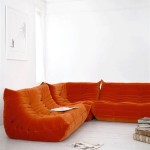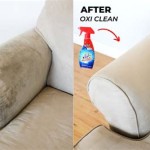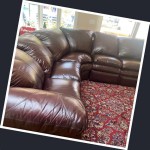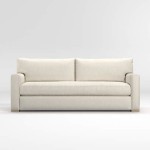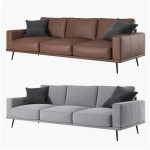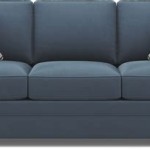Standard Size For Sofa Cushions
Finding replacement cushions or simply adding to existing seating can be a frustrating experience without a clear understanding of standard sofa cushion sizes. While there isn't one definitive "standard" across the industry, certain dimensions appear more frequently, providing a helpful framework for consumers.
Key Points Regarding Sofa Cushion Sizes
- No single industry standard exists.
- Dimensions are influenced by sofa style and manufacturer.
- Cushion depth and thickness significantly impact comfort.
The dimensions of sofa cushions are generally categorized by width, depth, and thickness. Width refers to the measurement across the front of the cushion. Depth refers to the measurement from the front edge to the back. Thickness, sometimes referred to as height, is the measurement from the bottom of the cushion to the top.
Common Width Ranges
- 20-24 inches: Frequently found in smaller sofas and loveseats.
- 24-28 inches: A common range for standard sofas.
- 28-32 inches: Often used in larger sofas and sectionals.
These width ranges are not absolute. Custom-made sofas and some manufacturers may utilize different dimensions. Measuring existing cushions provides the most accurate information for replacements.
Common Depth Ranges
- 20-22 inches: Typical for smaller sofas and chairs.
- 22-24 inches: A standard depth for many sofa styles.
- 24-26 inches: Often found in deeper, more relaxed seating.
The depth of a cushion directly impacts seating comfort. Deeper cushions generally provide more relaxed seating, while shallower cushions offer a more upright posture.
Common Thickness Ranges
- 4-6 inches: A standard thickness for many cushions, providing a balance between support and comfort.
- 6-8 inches: Offers a plusher feel, often found in more luxurious sofas.
- 8-10 inches: Provides extra cushioning and a deeper sink-in experience.
Cushion thickness influences both comfort and the overall aesthetic of the sofa. Thicker cushions create a fuller, more inviting look, while thinner cushions offer a more streamlined appearance.
Measuring Existing Cushions
- Use a tape measure to accurately determine width, depth, and thickness.
- Measure at the widest, deepest, and thickest points of the cushion.
- Record measurements in inches or centimeters for consistency.
Accurately measuring existing cushions is crucial for finding suitable replacements. Inaccuracies can lead to ill-fitting cushions that compromise both comfort and aesthetics. Always double-check measurements before ordering replacements.
Cushion Shapes and Styles
- Box cushions: Rectangular or square, offering a tailored look.
- T-cushions: Feature a top seam, creating a more traditional appearance.
- Knife-edge cushions: Have sharp, clean edges for a modern aesthetic.
The shape and style of the cushion influence not only the overall look of the sofa but also the fitting process. Replacing a T-cushion with a box cushion, for instance, might not yield the desired result. Understanding the different cushion styles is essential for making informed choices.
Cushion Fill Materials
- Foam: A common fill material, offering varying levels of firmness and support.
- Down feathers: Provide a soft, luxurious feel.
- Fiberfill: A synthetic alternative to down, offering a balance between comfort and affordability.
The fill material significantly impacts the cushion's comfort, durability, and maintenance requirements. Foam offers good support and retains its shape well. Down feathers provide a luxurious feel but require more frequent fluffing. Fiberfill is a cost-effective option that provides a comfortable, yet resilient fill.
Considering Sofa Style
- Traditional sofas: Often feature T-cushions with standard depths and thicknesses.
- Modern sofas: May utilize box cushions or knife-edge cushions with varying dimensions.
- Sectional sofas: Can incorporate a variety of cushion sizes depending on the configuration.
The style of the sofa often dictates the general dimensions and shape of the cushions. Considering the overall sofa style can provide valuable insights when selecting replacement cushions or adding additional seating elements.
Ultimately, careful measurement and consideration of sofa style and desired comfort levels are crucial for selecting the right cushion size. Consulting manufacturer guidelines or contacting furniture professionals can provide further assistance in navigating the nuances of sofa cushion dimensions.

Cushion Covers Pads How To Decide On Size Furn Com

At Cushion Source Our Standard Size Of Floor Pillows Or Least Most Popular Would Be 26 Descri Pillow Sizes Chart Throw Blue

Standard Sofa Cushion Size Conceptstructuresllc Com Decorative Pillow Sizes Bedroom Blue Pillows

Patio Cushion Size Guide At Home The Decor Holiday Super

Apollo Sofa Set Urban Ladder

Replacement Sofa Cushions The Cushion Warehouse

Sofa Dimensions For 2 3 4 5 6 Person Couches Diagrams Included Home Stratosphere

How Many Cushions Should You Put On A Sofa Simply

Cotton Big Sofa Cushion For Home Hotel Size 60x60 Cm 24 X Inches

Sofa Dimensions 101 Measuring For Your Perfect


